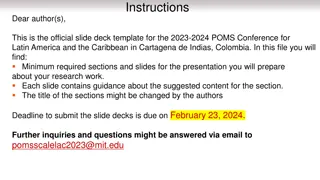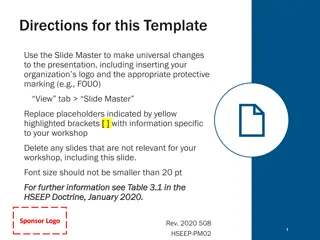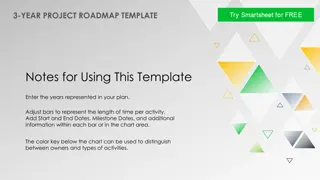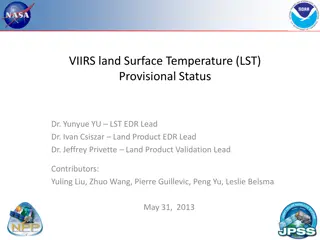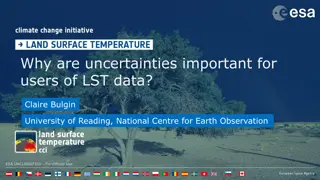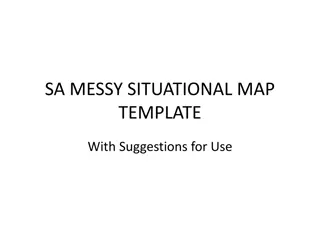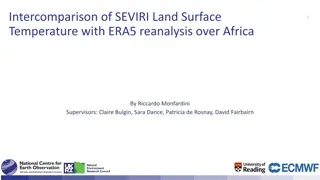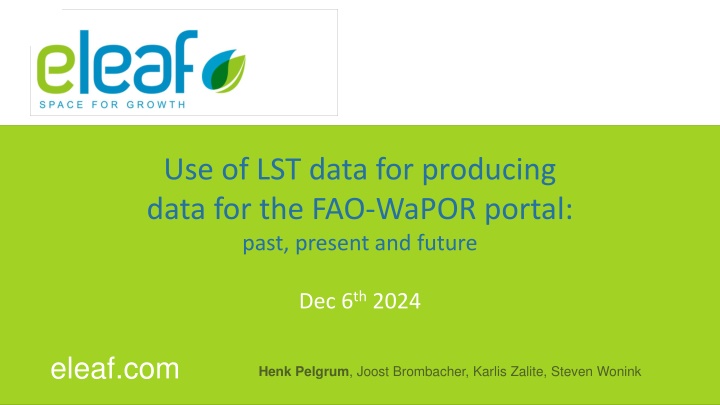
Utilizing LST Data for FAO-WaPOR Portal: Past, Present, and Future
The FAO-WaPOR portal integrates satellite data to monitor agricultural water productivity globally. It offers solutions for water and land productivity challenges, with training by IHE Delft and capacity building by IWMI. The database includes information on evapotranspiration, interception, net primary productivity, and more. Requirements state that data and software used should be open source, with tools like PyWAPOR enabling users to calculate data without additional costs. Different database versions cover various regions and levels, while models like ETLook and C-fix are employed for key components like evapotranspiration and soil moisture.
Uploaded on | 2 Views
Download Presentation

Please find below an Image/Link to download the presentation.
The content on the website is provided AS IS for your information and personal use only. It may not be sold, licensed, or shared on other websites without obtaining consent from the author. If you encounter any issues during the download, it is possible that the publisher has removed the file from their server.
You are allowed to download the files provided on this website for personal or commercial use, subject to the condition that they are used lawfully. All files are the property of their respective owners.
The content on the website is provided AS IS for your information and personal use only. It may not be sold, licensed, or shared on other websites without obtaining consent from the author.
E N D
Presentation Transcript
Use of LST data for producing data for the FAO-WaPOR portal: past, present and future Dec 6th2024 eleaf.com Henk Pelgrum, Joost Brombacher, Karlis Zalite, Steven Wonink
FAO - WaPOR WaPOR o Near real time global database using satellite data that allows the monitoring of agricultural water productivity at different scales o Capacity building in the use of WaPOR data for different applications o Generate solutions to local challenges linked to water productivity and land productivity as well as water management o Training is done by IHE Delft o Capacity building is done by IWMI o Data provision (v3.0) is ensured by eLEAF o Data provisions for previous versions was done by eLEAF and VITO
FAO-WaPOR requirements Data used for producing database data should be open source Software used for producing database is also open source o PyWAPOR (https://bitbucket.org/cioapps/pywapor/src/master/) General idea is that users should be able to calculate their own data without additional costs for data Currently we are on v3 of the dataset
FAO-WaPOR database content Evapotranspiration (separated into E, T) Interception Land Cover Classification (not in v3) Net Primary Productivity Phenology (not in v3) Precipitation Quality layers Relative soil moisture content for the rootzone Total biomass production Water productivity
FAO-WaPOR Coverage Database version Description V1 V2 v3 250 m 100 m 30 m 300 m 100 m 20 m L1 L2 L3 Continental level Basin level Irrigation scheme 250 m 100 m 30 m Database version Description V1 V2 v3 Africa Middle East Major watersheds Africa Global L1 Continental level Africa Middle East Major watersheds Africa Africa Middle East Pakistan Colombia 30+ areas L2 Basin level 20+ areas L3 Irrigation scheme 10+ areas
Models Models used for the main components: Evapotranspiration & Interception --> ETLook o NDVI o Surface Albedo o Soil Moisture o Meteorological data Net Primary Production --> C-fix o NDVI o Meteorological data Soil moisture --> Pixel-based trapezoid approach o Land Surface Temperature o NDVI o Meteorological data
Data providers Input Variable v1 V2 v3 NDVI MODIS Landsat MODIS Landsat Sentinel-2 MODIS VIIRS Landsat Sentinel-2 MODIS Landsat MODIS Landsat Sentinel-2 VIIRS Landsat Sentinel-2 Surface Albedo LST MODIS Landsat MODIS Landsat VIIRS Landsat Meteorological data MERRA GEOS-5 MERRA GEOS-5 (ag)ERA5 GEOS-5
ETLook Separate Penman-Monteith for soil and canopy Computes daily Interception, Evaporation and Transpiration Reduction of Potential ET through a soil moisture stress factor
C-Fix model Radiation based fPAR is a function of NDVI Uses similar soil moisture stress as ETLook for reducing NPP
Soil moisture model Trapezoid approach Pixel based instead of image- based
Soil Moisture: WaPOR vs SMAP A rudimentary comparison
Changes in versions related to inputs MODIS Tile data (v0-v2) -> VIIRS Swath data (v3) o MODIS/VIIRS Tiles are troublesome when going global! o Sinusoidal projection o Instead of using LST as a product, LST is derived from the brightness temperature For the 100m products (Africa/Middle East/Pakistan/Colombia) o Resampling -> Thermal sharpening o Resampling lead to errors on dry/wet boundaries
Coarse resolution LST products MODIS VIIRS Spatial resolution (m) Archive since MODIS 1000 2000 S-3 1000 2016 Sentinel-3 GCOM VIIRS 375 2011 (not very suitable for operational application) GCOM-C 250 2018 Euphrates Tigris
Thermal Sharpening https://github.com/radosuav/pyDMS PyDMS Feature selection and data preparation PyDMS application
Thermal sharpening example VIIRS Brightness Temperature November 16th, 2024 South-Africa SEntinel-2 Tile ID: 34HCH
Water Balance Closure Water Balance Equation: Precipitation (P) = Evaporation (E) + Transpiration (T) + Interception (I) + Discharge (Q) Assessment for four African catchments On average -1.8% difference between P and sum of E, T, I and Q Meaning: ETLook is capable of accurately estimating the ETI at catchment level, the model has no systematic bias that results in an unclosed water balance. The individual accuracy of E, T, and I is still unknown.
Validation Validation with EC-data in the USA Daily data Good consistency between L1 and L3 in general
Validation L1 vs L3 Spring Summer
Future outlook New high resolution sensors on the horizon (open data) Observations instead of artificial sharpened data for L2 and L3 Revisit time Sensor Resolution Launch date 3 days 3 days 4 days SGB-TIR TRISHNA LSTM 60 m 60 m 50 m 2029 2026 2028 - 2030
LST is integral part of the WaPOR data pipeline In the past resampled LST caused issues Currently thermal sharpening is used to provide high resolution LST Future versions will incorporate next generation high resolution LST open-source data Contact: henk.pelgrum@eleaf.com Wapor Database: https://data.apps.fao.org/wapor/


